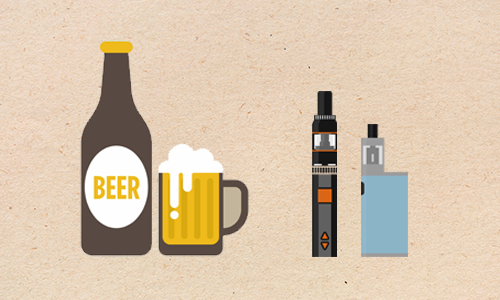
Following the Spring Budget on 6th March 2024, SARG experts Colin Angus and Duncan Gillespie take a look at what it means for alcohol and e-cigarette taxes.
Alcohol taxes
The Chancellor announced in his budget that he will continue with the long-term trend of freezing alcohol taxes. Once you account for inflation this actually means that taxes will fall in real terms and alcohol will become more affordable as a result.
We know from decades of research that lowering alcohol taxes tends to lead to increases in alcohol consumption and the problems it causes. Our previous research has estimated that duty cuts and freezes between 2013 and 2017 led to thousands of additional deaths from alcohol-related causes. The Chancellor justified his decision by arguing that it will help pubs, but the evidence suggests that this is unlikely to be the case.
Reducing alcohol taxes has a bigger effect on prices in shops and supermarkets than it does on prices in pubs, as tax makes up a much larger proportion of the price of shop-bought alcohol. So, far from helping pubs, cutting alcohol taxes will simply encourage the long-term drift away from pub-drinking and towards home-drinking. A much better way for the Chancellor to help pubs would be to use the ‘draught relief’ system introduced last year that provides a tax cut for most alcohol sold in pubs.
The Chancellor did however reject calls from industry to extend the delay in introducing reforms to wine taxes. The Government reformed its alcohol tax system in 2023 to ensure stronger drinks always attracted more tax. However, it delayed this change for wine to allow businesses time to adjust.
Going ahead with the change will mean there are now incentives for businesses to lower the strength of the wines they make and sell so they attract less tax and are less harmful to consumers. Something that we have already seen happen with beer producers. This will make the alcohol tax system simpler overall, more rational and better for public health.
Follow Colin Angus on X @VictimOfMaths
E-cigarette taxes
The surge in disposable e-cigarette usage in the UK, particularly among young people, has raised concerns about protecting non-smoking young people from nicotine addiction, addressing the environmental impact of discarded electronic waste, and the potential for transitioning to tobacco smoking.
To address these issues, the Government has implemented various policy measures, with the latest being a tax on e-cigarette liquid announced in the Spring Budget. Other recent measures include the smoke-free generation policy, prohibiting tobacco sales to those born after 1st January 2009, and a ban on disposable e-cigarettes.
Scheduled to take effect in October 2026, the new e-cigarette liquid tax aims to reduce e-cigarette consumption by increasing prices. While studies in the United States indicate that higher prices reduce usage, there is a lack of UK-specific data, which makes it hard to predict how the new tax will affect consumer behaviour. There is also a lack of data on how responses are likely to vary by age and income. The impact of the tax will also depend on how it interacts with existing policies like the smoke-free generation initiative and the disposable e-cigarette ban.
The response of the e-cigarette industry to the tax remains uncertain. The Government aims to encourage manufacturers to lower the nicotine content of e-cigarettes, but past experience suggests industry responses may not align with intentions. Consideration is also needed about how the nicotine concentration of e-cigarettes relates to nicotine addiction in users.
The Government is keen that the new e-cigarette liquid tax does not make tobacco smoking more appealing. To guard against this, it plans to introduce a one-off rise in tobacco tax at the same time as the new vape tax. There is clearly now a need to monitor the difference in prices between e-cigarettes and tobacco to ensure that the goal of reducing rates of tobacco smoking is not being undermined by the new policy.
If consumers do not alter their behaviour in response to higher e-cigarette prices, the government stands to gain more tax revenue. The Government proposes to allocate this revenue to the NHS and initiatives to support people to quit tobacco smoking. This could include providing people with cheaper e-cigarettes to support tobacco smokers in quitting, as with the Government’s recently introduced ‘Swap to Stop’ scheme.
Follow Duncan Gillespie on X @drduncgillespie
Further reading
HM Treasury / HMRC Vaping Products Duty Consultation – Gathering views on their proposals for a new UK-wide duty on vaping products.
Understanding the vaping market – Commissioned research by the HMRC on the e-cigarette market released at the same time as the Spring Budget.
Tobacco and new nicotine product pricing policy: past, present and future (February 2024) An overview of Duncan Gillespie’s talk at a SPECTRUM Consortium event exploring the potential impact of various pricing strategies on tobacco use and public health.
The Price of Alcohol: Explained (October 2023) Colin Angus is featured in this video by the Institute of Alcohol Studies which explains how the cost of alcohol impacts consumption rates and subsequent harm, how alcohol duties have changed over time, how minimum unit pricing works and whether it is effective in reducing drinking, and the cost of alcohol harm to the economy.
Alcohol duty explained: Cuts, inflation, and public health (November 2022) Blog post from Colin Angus for the Alcohol Health Alliance.
Why the Chancellor’s freeze on alcohol duties is bad news for pubs (March 2021) Blog post from Colin Angus for Alcohol Change UK
Hatchard J, Buykx P, Wilson L, Brennan A, Gillespie D (2023) Mapping alcohol and tobacco tax policy interventions to inform health and economic impact analyses: A United Kingdom based qualitative framework analysis, International Journal of Drug Policy, DOI: https://doi.org/10.1016/j.drugpo.2023.104247
Hatchard J, Buykx P, Brennan A and Gillespie D (2023) Options for modifying UK alcohol and tobacco tax: A rapid scoping review of the evidence over the period 1997–2018 [version 3; peer review: 2 approved], NIHR Open Research, 3:26. DOI: https://doi.org/10.3310/nihropenres.13379.3
